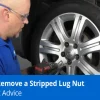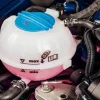Have you ever noticed your car’s tires looking a little deflated? It happens to the best of us, and luckily, inflating your tires is a quick and easy fix. Many gas stations have air pumps available for customers to use, but for those who have never used them before, it can be a little daunting. In this blog, we will walk you through step-by-step on how to inflate your tires at a gas station, so you can get back on the road safely and quickly.
Plus, we’ll throw in a few tips and tricks to keep in mind along the way! So grab your car keys and let’s dive in.
Table of Contents
Check Your Tire Pressure
When it comes to ensuring your vehicle is operating at its best, checking the tire pressure is crucial. Many gas stations have air compressors available to customers and they often have guides on how to properly use them. To begin, locate your vehicle’s manufacturer’s recommended PSI (pounds per square inch) for your tire pressure.
This information can be found on the driver’s side door jamb or in your vehicle’s user manual. Remove the cap from the tire valve stem and attach the air hose to it. Set the pressure to the recommended PSI and inflate the tire accordingly.
It’s important to not overinflate the tire as this can lead to a blowout and decrease fuel efficiency. After inflating, double-check the pressure with a tire pressure gauge to ensure accuracy. By regularly checking and maintaining your tire pressure, you can improve safety, prolong the lifespan of your tires, and potentially increase fuel efficiency.
Remember to check your tire pressure at least once a month and before long road trips.
Use a Tire Pressure Gauge
Checking your tire pressure regularly is important for ensuring safe driving and extending the life of your tires. But how do you check your tire pressure accurately? The answer is by using a tire pressure gauge. This simple device measures the amount of air pressure inside your tire, helping you maintain the correct amount of pressure recommended by your vehicle’s manufacturer.
Over-inflated or under-inflated tires can adversely affect your vehicle’s performance and fuel efficiency while also increasing the risk of accidents due to tire blowouts. By using a tire pressure gauge, you can rest assured that your tires are properly inflated, providing you with a smooth, safe, and fuel-efficient driving experience. So, make it a habit to check your tire pressure regularly and keep your tires in optimal condition.

Consult Your Vehicle Manual
When it comes to maintaining your vehicle, checking your tire pressure is an important but often overlooked task. One of the best ways to ensure your tire pressure is at the correct level is to consult your vehicle manual. Your vehicle manual provides information about the recommended tire pressure levels based on the type and size of your tires.
This information is crucial as underinflated or overinflated tires can lead to uneven tread wear, decreased fuel efficiency, and even tire failure. So, take a few minutes to grab your vehicle manual and locate the recommended tire pressure levels for your car. Trust me, your tires (and wallet) will thank you for it!
Locate the Air Pump Station
If you’re wondering how to put tire pressure on your car at a gas station, the first step is to locate the air pump station. Most gas stations nowadays provide compressed air to their customers, and the air pump station is usually tucked away at the corner of the gas station. Once you’ve parked your car near the air pump station, you’ll need to check your tire pressure using a tire pressure gauge.
Simply unscrew the valve cap on each tire and attach the pressure gauge to the valve stem. The gauge will show you the current pressure in each tire, and you can inflate or deflate the tires as necessary using the air pump. Make sure to check the recommended tire pressure for your particular car model and adjust accordingly.
It’s always a good practice to check your tire pressure at least once a month and before long road trips to ensure your safety on the road.
Look for the Air Pump Station
If you’re a fan of cycling, you know that nothing ruins a ride quite like a flat tire. That’s why it’s important to be prepared, and one essential tool for any cyclist is an air pump. But what happens if you’re out riding and your tires start to feel low, but you don’t have your own pump? Fear not, as many cities and towns now have designated air pump stations, usually located near popular bike paths or parks.
These stations are easy to spot, often resembling a tall kiosk with a large air compressor and a hose attached. Look for the nearest one in your area so that you don’t have to worry about being stranded with a flat. Next time you head out for a ride, be sure to keep your eyes peeled for the air pump station.
With this helpful tool on hand, you can keep cruising no matter what the road throws your way.
Check if the Air Pump Station Works
When it comes to checking if the air pump station works, the first step is to locate the station. Depending on the gas station, the air pump may be located near the fueling area or in a separate section of the lot. The quickest way to locate it is to look for the sign that reads “Air.
” Once you find it, park your vehicle as close as possible and check the pump station for any visible damages or defects. You can also check the pressure gauge to ensure the display is working correctly. If you detect any issues, it is best to seek the assistance of an onsite staff member.
Keep in mind that properly inflated tires can improve your gas mileage and safety on the road. So, next time you’re worried about low tire pressure, don’t hesitate to check the air pump station and top up your tires.
Prepare Payment
When it comes to preparing payment for using an air pump station, one of the most important steps is locating the station itself. Depending on where you are, finding the pump can be a bit of a challenge. In some cases, you may need to ask around to figure out where it is, or rely on the maps and apps provided by your preferred gas station or service provider to lead you in the right direction.
Once you’ve located the pump, you’ll need to carefully consider your payment options. Many pumps offer a variety of payment methods, from credit cards and online payments to coins and cash. Be sure to read all of the instructions and guidelines carefully to avoid any confusion or unexpected fees.
Above all, remember to be patient and take your time – while it can be tempting to rush through the process and get back on the road as quickly as possible, taking the time to ensure that your payment is properly processed can save you time, money, and hassle in the long run.
Inflate Your Tires
Heading to the gas station to inflate your tires can be confusing if you’re unsure of how to do it. First, you’ll need to locate the air pump and ensure you have enough change or card for payment. Then, check the recommended tire pressure for your vehicle, which can be found in the owner’s manual or on a sticker inside the driver’s side door.
Once you have this information, remove the cap from the valve stem on your tire and attach the air hose securely. Press the button to start the pump and fill the tire to the recommended pressure, checking frequently with a tire gauge. Once you’ve reached the desired pressure, remove the air hose and replace the valve stem cap.
Properly inflated tires can improve gas mileage, handling, and overall safety, so it’s essential to make sure your tires are adequately inflated. With these simple steps, you can easily put tire pressure at a gas station to keep your vehicle running smoothly and safely on the road.
Remove the Valve Cap
“Inflate Your Tires” Removing the valve cap is the first step in inflating your tires. The valve cap is the small plastic or metal cap that covers the valve stem on your tire. It is important to remove the cap before inflating your tire to ensure that you can access the valve stem.
This may seem like a small step, but it is crucial to the tire inflation process. When the valve cap is left on, air cannot flow through the valve stem and into the tire. Without air flow, you will not be able to inflate your tire properly.
It’s similar to trying to water a plant through a closed watering can nozzle – it’s just not going to work! So, take care to remove the valve cap, and keep it somewhere safe while you inflate your tire. Once you have inflated your tire, make sure to screw the valve cap back onto the valve stem securely. This will help prevent dust and debris from getting inside the valve stem and causing damage to your tire.
Attach the Air Hose Valve
Inflating your tires regularly is an essential part of maintaining your vehicle’s health and performance. It only takes a few minutes and can make a significant difference in your driving experience. To start, ensure the air hose valve is attached correctly to the tire.
You can find the valve stem on the outer edge of the rim, typically covered by a small metal cap. Remove the cap, and press the air hose valve onto the stem firmly. Make sure it is securely attached before proceeding.
Once you have attached the valve, it’s time to inflate your tire to the recommended pressure. This information can be found in your vehicle’s manual or the sticker attached to the driver’s side door. Overinflating or underinflating your tires can lead to decreased fuel efficiency and affect your vehicle’s handling and safety.
Regularly checking and inflating your tires is a simple task that can enhance your driving experience and keep you safe on the road. So why not give it a try today?
Inflate According to Recommended Pressure
If you want to ensure that your car gives you a smooth and safe ride, it’s important to keep your tires properly inflated. Not only does maintaining the recommended tire pressure make your car more fuel-efficient, but it also prevents tire wear, extends the life of your tires, and most importantly, reduces the risk of a dangerous blowout. So, next time you’re checking your tire pressure, make sure to consult your car’s manual to find the recommended pressure levels.
Don’t underestimate the importance of this simple task; overinflated tires are more prone to bursting on hot days, while underinflated tires are at greater risk of overheating and exploding. By keeping your tires inflated to the right level, you’ll give yourself the peace of mind that comes with knowing you’re driving safely and efficiently.
Double-Check Your Tire Pressure
Tire pressure is important when it comes to driving safely on the road. One way to check and adjust tire pressure is by visiting a gas station. Many gas stations have tire pressure pumps that you can use for free or a small fee.
Start by checking the recommended tire pressure for your vehicle, which can be found in the owner’s manual or on the driver’s side door jamb. Then, remove the valve cap and attach the pump to the valve stem. Adjust the pressure with the pump until it reaches the recommended level.
However, it’s important to double-check your tire pressure with a tire gauge to ensure accuracy. It’s also important to note that tire pressure can change with temperature, so it’s a good idea to check it regularly and adjust as needed. Keeping your tires properly inflated can improve fuel efficiency, prolong the life of your tires, and provide better handling on the road.
So next time you’re at the gas station, take a few extra minutes to check your tire pressure and give yourself the peace of mind that comes with safe driving.
Use the Tire Pressure Gauge Again
After inflating your tires to the recommended pressure level, it’s important to double-check your work using a tire pressure gauge. This tool measures the actual pressure inside the tire, giving you a more accurate reading than just eyeballing it. Even if you’re confident in your ability to estimate the pressure based on how the tires look, it’s still a good idea to use the gauge as a second check.
Sometimes tires can appear over-inflated or under-inflated when they’re actually at the correct pressure, so using a gauge is the best way to ensure your safety on the road. By taking this extra precaution, you can catch any potential issues before they become dangerous and enjoy a smooth ride. So, take a few minutes to give your tires a double-check with a tire pressure gauge and hit the road with confidence.
Add or Release Air as Needed
Checking your tire pressure regularly is crucial to ensuring your vehicle runs smoothly on the road. A tire that is overinflated or underinflated can lead to problems such as decreased fuel efficiency, poor handling, and even a blowout. To avoid these issues, it is important to double-check your tire pressure and add or release air as needed.
You can find the recommended pressure for your tires in the owner’s manual or on a sticker inside the driver’s side door. It is important to use a tire pressure gauge to ensure you have the correct pressure. Neglecting to maintain your tire pressure could result in costly repairs and endanger your safety on the road.
So, make sure to check your tire pressure regularly and keep them properly inflated for optimal performance.
Fill Your Tires on a Regular Basis
If you’re wondering about how to put tire pressure at a gas station, it’s easier than you might think! First, find the air filling station at the gas station. Then, remove the cap from your tire’s air valve. Check the recommended pressure for your tires (this information is usually located in your car’s owner’s manual or on a sticker inside the door jamb).
Next, use the air hose to fill your tires to the recommended pressure, and check the pressure with a tire gauge periodically to ensure you don’t overfill. It’s important to fill your tires on a regular basis, as proper tire pressure can improve your gas mileage, handling, and overall safety while driving. Plus, with gas stations usually offering free air, it’s an easy and convenient way to keep your tires in good shape.
So next time you fill up your tank, take a few minutes to give your tires some love, and they’ll thank you in return!
Conclusion
In conclusion, filling up your tires at a gas station might seem like an easy task, but it’s important to approach it with caution and intentionality. Remember to check your tire pressure regularly, use a reliable pressure gauge, and follow the recommendations in your car manual. And don’t forget to take a deep breath and channel your inner pit crew member as you fill up those tires.
With these tips in mind, you’ll be cruising down the road in no time – and, hopefully, feeling like a tire pressure pro.”
FAQs
What is the importance of maintaining proper tire pressure?
Maintaining proper tire pressure helps improve fuel efficiency, extends tire life, and provides better traction and handling.
How do I know what tire pressure to put in my tires?
The recommended tire pressure can be found in your vehicle owner’s manual, on the tire information placard located on the driver’s side doorjamb, or on the tire itself.
Is it safe to put air in my tires at a gas station?
Yes, it is safe to put air in your tires at a gas station. Make sure to use the correct pressure gauge and follow the instructions on the air pump.
How often should I check my tire pressure?
It is recommended to check your tire pressure at least once a month or before long trips.
Can overinflating my tires be harmful?
Yes, overinflating your tires can cause uneven tire wear, reduce traction, and make the ride uncomfortable.
Can I adjust my tire pressure if I am carrying extra weight in my vehicle?
Yes, you may need to increase your tire pressure if you are carrying extra weight in your vehicle. Refer to your owner’s manual or tire placard for the recommended pressure.
How do I adjust my tire pressure at a gas station?
First, remove the valve cap and use a tire pressure gauge to check the psi. If the pressure needs to be adjusted, use the air pump to add or release air until you reach the recommended psi. Don’t forget to replace the valve cap when finished.



